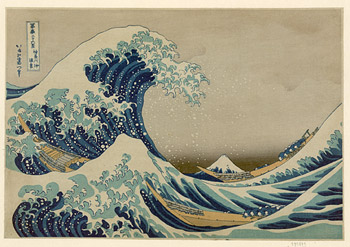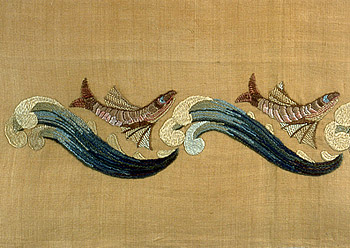Deerfield Arts & Crafts home page
Comparisons
Deerfield Embroidery and Japanese Prints


Margaret Whiting once observed of the stylistic sources she saw in colonial embroidery, "...when the Orient was translated by the very English mind of the colonial woman it had a curious archaic quality conventional in essence if not in theory. Rub oriental art through a Puritan sieve and how odd is the result!1
Artists Margaret Whiting and Ellen Miller, co-designers for the Deerfield Society of Blue and White Needlework likewise borrow from various national and international styles. And, as had their colonial predecessors, they filtered those sources through their own unique vision. Ellen Miller's Over the Bounding Waves is indebted to Japanese ukiyo-e woodblock prints, such as Hokusai's most famous The Great Wave off Kanagawa, for her subject matter, color scheme and for the manner in which she transforms natural elements, in this case waves and fish, into stylized motifs which are arranged into an artful composition. Whereas for Hokusai the stylized wave becomes the dominant actor in an epic story of the frailty of man in the face of overwhelming natural forces, Ellen Miller elevates a harmonious use of rhythmic pattern over narrative, in a manner that is quite appropriate to the tradition of her medium, embroidery. Ultimately Miller's series of abstracted waves is one of two horizontally-oriented motifs on an otherwise insistently-flat color field, the wave pattern draws the eye in one direction and three flying fish lead the eye in the other.
- Margaret Whiting, Notes on Village Industries and the DSBWN, c. 1901.
Left image: The Great Wave off Kanagawa, Katsushika Hokusai, Collection of the Library of Congress
Right image: Over the Bounding Waves, Deerfield Society of Blue & White Needlework, Memorial Hall Museum, Pocumtuck Valley Memorial Association